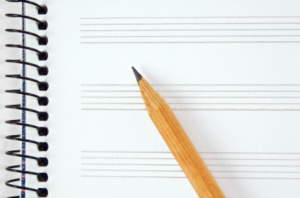Any student of jazz music (myself included) will benefit in the following ways from transcribing jazz solos:
- Jazz Demystification: Often times, even within a single transcribed solo, the transcriber will notice repetition of ideas. It doesn’t take long to realize that even well-known, masterful players are working with finite musical vocabularies. Just knowing this can give a student hope that playing jazz at a high level is achievable.
 (Musical) Vocabulary Expansion: It has been said that jazz is one field where plagiarism is actually encouraged! If you hear someone play a phrase that captures your interest, it’s free for the taking. Go and get it; and then assimilate it into your own solos.
(Musical) Vocabulary Expansion: It has been said that jazz is one field where plagiarism is actually encouraged! If you hear someone play a phrase that captures your interest, it’s free for the taking. Go and get it; and then assimilate it into your own solos.- Nuance Familiarization: Take note of every detail — articulations, slur patterns, tonguing, dynamics, sound character/quality etc., and copy these.
- Swing Feel Development: If your swing feel seems forced or unnatural, play along with your transcriptions, trying to line up your eighth notes with the recording. Doing this at 1/2 speed is twice as difficult and doubly effective. Aim to match articulations exactly. If you play a wind instrument, note and try to replicate all accents and tonguing vs. slurs.
- Improved Sight Reading: Learning to organize and present beats within a measure will undoubtedly have a positive impact on your sight reading. (It did for me!)
The respected jazz trumpeter, Brian Lynch is quoted as saying, “I think that it is important to try to sound like someone, especially early in your development.” This statement complements Clark Terry’s famous educational creed to “Imitate, Assimilate and Innovate.”
What to do with a transcription after “writing it down”:
After notating a solo, that is when the work really begins! Don’t make the mistake of just reading it a few times and then moving on. Here are some suggestions to get the most out of your transcribed solo:
- Set aside the written transcription and start again, learning it by ear: Many of the jazz greats learned solos, but didn’t write them down. You usually can’t go wrong following the example of those who have succeeded before you.
- Learn it at 1/2 speed: see point #4 above. Use software like “The Amazing Slow Downer” or simply adjust the playback speed on YouTube.
- Work towards playing it up to tempo: Like any classical etude, start under tempo and gradually increase your metronome’s speed.
- Extract and catalog licks: Look for lines played over frequently recurring harmonic situations and progression. Put these into a notebook.
- Memorize the extracted licks in several keys: Start with common keys like F, Bb, Eb, and G (concert). Eventually, systematically learn these licks in 12-keys. Always remain aware of the harmonic context in which the licks were played.
- “Plug-in” the licks into songs: a ii – V – I lick from one tune, can be applied to any tune containing a ii – V – I harmonic progression. After practicing the extracted lick in the key of the tune you are playing, practice plugging it in, in the appropriate spot, while playing with a Jamie Aebersold play-a-long recording.
- Analyze lines and write variations: Study your extracted lines, and identify their defining components. What scalar or rhythmic ideas are incorporated? Try writing a variation. After all, isn’t the end goal to one day sound like YOU?
- Analyze Phrasing: Going back to your original transcription, take note of the soloist’s phrase structure. How is space/resting utilized? When double-time is incorporated, for how long is it utilized before switching back to eighth notes?
Knowing why and what to do should be helpful in your quest to learn the jazz style and solo language through transcribing. Good luck!

